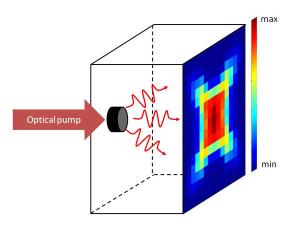Half a century since the first working laser kick-started a technological revolution in the field of optics, a new device promises to do the same for acoustics. UK and Ukrainian physicists have built the first "saser", or sound laser, able to generate terahertz-frequency sounds.
A laser produces photons that travel in a tight beam instead of dispersing outwards like a regular beam of light. A saser achieves the same for sound waves, says Tony Kent at the University of Nottingham, UK.
Although it's not the first saser ever constructed, it is the first able to produce beams at terahertz frequencies, much higher even than those used for medical ultrasound imaging. Terahertz sound may be largely a curiosity today, says Kent, but being able to produce it in controllable beams could unleash new ideas and applications.
"Fifty years ago many eminent scientists said that light amplification by the stimulated emission of radiation [lasers] was no more than a scientific curiosity," says Kent, but lasers are now used for everything from digital storage and cancer treatment to weaponry.
Kent worked with Nottingham colleagues Mohamed Henini and Paul Walker, as well as physicists at the VE Lashkarev Institute of Semiconductor Physics in Kiev, Ukraine, to design and test the device.
Echo amplifier
The new saser is a semiconductor stack, made from thin, alternating layers of gallium arsenide and aluminium arsenide.
To fire the device, the upper part of the sandwich is exposed to an intense light beam. That excites electrons in the material, which then release sound waves, or phonons.
Those reach the lower part of the sandwich where they bounce off the interfaces between different layers. The spacing of the layers has been carefully chosen so that the weak echoes combine into stronger sounds in which all of the phonons are synchronised.
Those strong phonons reflect back into the upper sandwich where they interact with the light-excited electrons – causing them to release further phonons and amplify the signal.
The result is the formation of an intense series of synchronised phonons inside the stack, which leaves the device as a narrow saser beam of high-frequency ultrasound.
Although light is currently used to "pump" the saser, it should be possible to achieve the same effect electrically too, says Kent.
Fastest yet
Saser beams that operate at much lower frequencies, in which the phonons oscillate a billion times per second (gigahertz) rather than a trillion times per second (terahertz), have been made before.
However, they have had little impact because there are other methods of generating sound at such frequencies, says Kent. "The saser could have a much bigger impact at terahertz frequencies, where other methods of generating coherent sound waves are not as well developed."
His team designed and built a similar saser in 2006, but evidence it actually worked was weak. "The results in our new paper are probably the strongest evidence for terahertz sasing yet produced," he says.
The team detected the saser by measuring its effect on a surface some distance away. They found that it caused phonons to appear in the surface in a confined spot (see image), the equivalent of seeing the dot of a laser pointer on a wall.
Chi-Kuang Sun is a laser specialist at the National Taiwan University in Taipei City. "It is a great work," he says, adding that it could provide a new way to image very small objects. "A high-energy coherent phonon source like a saser is the best tool we can have to noninvasively probe the unknown nanoworld."
Using sasers to manipulate electrons inside semiconductors could result in terahertz-frequency computer processors that would be much faster than the gigahertz frequency chips of today, says Kent.
Journal reference: Physical Review B, in press

The saser produces a highly focused beam that is similar to the way
a laser pointer produces a red spot when it hits a wall
(Image: Tony Kent and American Physics Society)
(From http://www.newscientist.com/article/dn17310-most-powerful-sound-laser-to-shake-up-acoustics.html) |